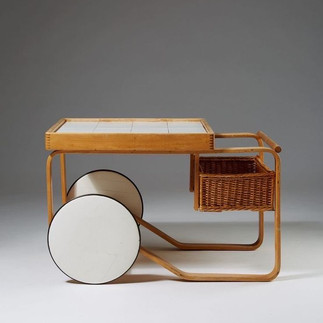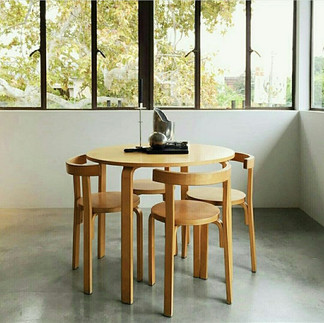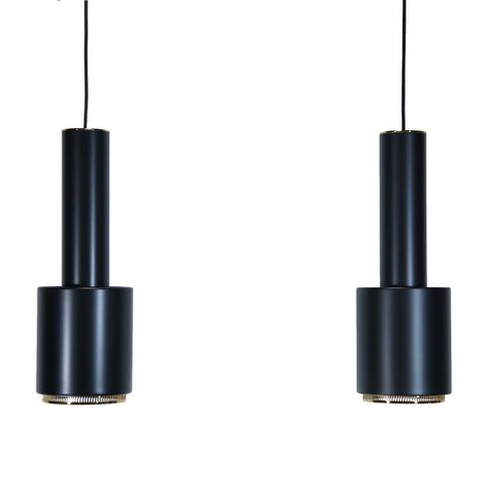Alvar Aalto : the spectacular approach to design and how to introduce it into your home
- Beatrice Bodasca
- Apr 11
- 7 min read
The Alvar Aalto's vision of functional, humane, and nature-friendly design has left its mark on modern architecture and furniture. Through his buildings, furniture, and ideas, Aalto successfully bridged the gap between modernism and a more organic and warm approach to design. Alvar Aalto's legacy continues to influence not only Scandinavian design but architecture and furniture around the world.
In this article, we explored Alvar Aalto's impact on functional architecture, Scandinavian design, and modern furniture design. If you're looking to learn more about this iconic designer and how to introduce his works into your home you're in the right place.
Alvar Aalto remains one of the most influential architects and designers of the 20th century.

Alvar Aalto: The Visionary Architect and Designer
Alvar Aalto (1898-1976) is one of the most influential figures in modern design and 20th-century architecture. Born in Finland, Aalto successfully combined functionality and aesthetics, while respecting the environment and the needs of the user.
1. Who was Alvar Aalto?
Alvar Aalto was born in Kuortane, Finland, in 1898. After graduating as an architect in 1921 from the University of Arts and Crafts in Helsinki, Aalto quickly made a name for himself in the world of architecture. He is recognized for his innovative designs and unique approach, which combined international modernism with elements of Finnish tradition.
Aalto was not only an architect, but also a designer of objects and furniture. He created a wide range of furniture pieces that are now icons of modern design. His architectural and design works are part of an approach aimed at humanizing spaces and making them more in harmony with nature.
2. Scandinavian Design: The Influence of Alvar Aalto
Scandinavian design is recognized worldwide for its simplicity, functionality, and understated beauty. Alvar Aalto played a pivotal role in the development of this movement. In Finland, Aalto successfully reconciled the principles of modernism with a warm, organic approach, far removed from the cold minimalism found in other forms of design.
Aalto was particularly successful in humanizing spaces through the intelligent use of wood and other natural materials. His work influenced not only architecture but also the art of furniture and interior design. Creations such as the bent plywood chairs and the famous Aalto tables are perfect examples of this blend of functionality and natural aesthetics.
3. Alvar Aalto's Functional Architecture
One of the key principles of Aalto's architecture is functionality. His work aimed to improve the lives of its users while respecting the environment. Aalto believed that architecture should adapt to humans, rather than the other way around. His buildings were therefore designed to be practical and comfortable, with particular attention paid to natural light, ventilation, and harmony with the landscape.
One of Alvar Aalto's most famous works is the Finnish Pavilion, designed for the 1939 World's Fair in New York. The building is distinguished by its use of organic forms and natural materials, characteristics that would become the hallmarks of Aalto's work.
Another iconic example is Villa Mairea, located in Noormarkku, Finland, a masterpiece that combines modernist architecture with elements of Finnish tradition. This villa is a perfect example of the integration of nature and design in a harmonious living environment.
4. Alvar Aalto's Impact on Modern Furniture
Alvar Aalto is also renowned for his modern furniture designs, which continue to be produced and used worldwide. Among his most famous creations is the Paimio chair, designed in the 1930s for the Paimio Hospital. This chair, designed for use by tuberculosis patients, combines comfort and ergonomics. It is now considered one of the most iconic pieces of Scandinavian design.
Aalto's tables, characterized by their elegant curves and choice of material—often plywood—are also classics. These pieces of furniture perfectly illustrate his humanist approach to design, where form follows function while preserving a sense of aesthetics.
Aalto always sought to create furniture that was not only beautiful, but also functional. His use of wood, particularly curved plywood, revolutionized the furniture industry, and many contemporary designers are still inspired by it today.
The Paimio armchair is elegant, comfortable, and easy to mass-produce. The curved plywood element, which serves as both the seat and back, is suspended from a solid bent birch wood structure.
Its profile, which seems to multiply into a series of flowing lines, is particularly spectacular.
5. Aalto's Design Principles: Nature, Simplicity, and Humanity
Alvar Aalto always advocated a human-centered approach to design. He believed that objects and spaces should be designed for the comfort of the people who used them. His design was functional while being deeply respectful of the environment and the materials used. He firmly believed in the importance of simplicity in design, but a simplicity that was not cold or impersonal.
Another fundamental principle in Aalto's work is the use of nature. His buildings and furniture are often designed to blend harmoniously into their natural surroundings. Whether in the large windows allowing abundant natural light or in the choice of materials such as wood and stone, nature plays a central role in his approach to design.

6. Aalto's Architectural Projects: A Lasting Legacy
In addition to his furniture designs, Alvar Aalto also left a vast architectural legacy. Among his most famous projects are:
Paimio Hospital: This building, designed in the 1930s, is a perfect example of his attention to functionality. The hospital's architecture was designed to enhance patient healing, with rooms oriented to maximize exposure to natural light and optimal air circulation.

Viipuri Library: This project, built in the city of Viipuri (now in Russia), is a masterpiece of modern architecture, combining simple geometric forms with a deep consideration of ergonomics and light.
The Alvar Aalto Museum: Located in Jyväskylä, Finland, this museum is a beautiful retrospective of his works and architectural philosophies. The building itself, an elegant and functional structure, embodies the essence of Aalto's work.
7. Aalto and the Modernist Movement: A Humanist Vision
Aalto is often associated with the modernist movement, which transformed architecture and design in the 20th century. However, unlike other modernist architects who advocated a strictly geometric and minimalist style, Aalto always sought to incorporate more organic and natural elements into his works. He often asserted that modernism should not be rigid, but rather should respond to human needs.
His approach had a tremendous influence on generations of architects and designers, and his work continues to be studied and admired today.
8. Alvar Aalto: Living Legacy
Alvar Aalto is a pivotal figure in the history of design and architecture. His work continues to shape the world of modern design, with furniture that remains popular and buildings that remain models of functionality and beauty. His legacy lives on through his works, his ideas, and his influence on future generations of designers.
The Aalto House, the Alvar Aalto Museum, and other institutions dedicated to his work are testament to the lasting impact he had on the world of design and architecture.

How to incorporate Aalto's works into your home?
Opt for iconic Aalto furniture pieces.
Aalto designed many iconic pieces that fit easily into a modern, minimalist, or even more classic interior. Here are a few key pieces:
✅ Chair 69
A wooden chair with a simple, sturdy, and comfortable design.
Perfect around a dining room table or as a side chair in a living room.
✅ Paimio Armchair
Ideal for a reading corner or a bright living room.
Its bentwood frame and sloping seat offer both design and ergonomics.
✅ Stool 60
A classic of Finnish design.
Can be used as a seat, side table, or stand for plants or decorative objects.
Available in several colors and finishes.
✅ Aalto Table (Model 91 or 95)
Soft lines and a light wood frame: perfect for a Nordic dining room or a sleek office.
2. Choose a palette inspired by nature
Aalto loved natural materials and soft hues. For an interior that reflects his style:
Use light wood (birch, pine, oak) for furniture, floors, or walls.
Opt for neutral tones: white, beige, soft gray, olive green, sand.
Add natural textiles: linen, wool, cotton, in earthy or pastel tones.
🎨 This creates a warm atmosphere, inspired by Finnish design.
3. Play with natural light—like Aalto
Aalto said that natural light should "shape the space." Here are some tips to imitate him:
Multiply the openings or choose very fine linen curtains to avoid blocking the light.
Use mirrors to reflect light and make the space appear larger.
Focus on lamps with organic shapes, like his famous A110 ("Hand Grenade") or A330S ("Golden Bell") lamps.
4. Consider a functional and fluid layout
Aalto was obsessed with the idea of a fluid space, without clutter, where each element has a clear role.
Limit furniture to what's strictly necessary.
Create natural flow patterns within the room.
Focus on soft, curved shapes, typical of the Aalto style, to avoid harsh angles.
5. Add touches of Nordic art and culture
To take the Aalto vibe even further:
Include architectural posters of his iconic buildings (Villa Mairea, Viipuri Library, etc.).
Add blown glass objects from the Iittala brand, with which Aalto collaborated (including the famous Aalto vase).
Choose handcrafted rugs or cushions with soft geometric patterns.
Bonus: Combining Aalto with other styles?
Yes, absolutely!
Aalto pairs very well with Japanese design (Japandi style), as both promote simplicity, nature, and functionality.
It also works well in a bohemian chic style, adding raw textiles and green plants.
Even in a contemporary or industrial interior, bentwood pieces bring softness and balance.
✨ In summary: How to integrate Alvar Aalto into your decor?
Key element | Practical advice |
Furniture | Choose one or two iconic pieces (stool, armchair, table) |
Colors and materials | Light wood, natural tones, simple textiles |
Light and ambiance | Maximize natural light, organically designed lamps |
Layout | Clean, fluid space, without clutter |
Cultural details | Nordic art, Aalto vase, handmade rugs |





























